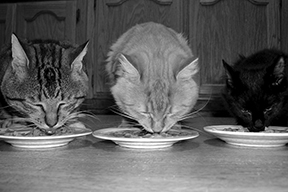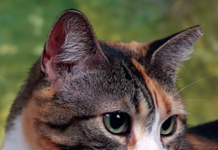With all the marketing claims about the virtues of canned and dry food, it can be daunting to choose between them. Which is better tasting and which is the better value? The answers just might surprise you. Nutritionist Joseph Wakshlag, DVM, Ph.D, Associate Professor at the Cornell University College of Veterinary Medicine, provides clarity in this Q. and A. to help you move past hype to good health for your cat.

Bigstock
288
Q. Which is more nutritionally sound — canned or dry food — and why?
A. I would say they are pretty equal in terms of nutritional soundness, and there are many brands and styles. They go through similar manufacturing processes, although kibble gets extruded (a shaping and drying process) and canned gets retorted (heated at high temperature in a retort sterilizer), so it has to go through a heating process. For cats, canned is slightly better. Cats don’t like new things, so give kittens both kibble and canned so they know both. If they end up with issues where one or the other is preferred due to a medical condition, you can choose the appropriate form.
Q. Which has the most calories?
A. Volume to volume, dry is more calorically dense and canned is typically higher in fat. If I took water out of the canned food and pulverized it into powder, measured a gram of each for caloric density, canned would be more calorically dense because it’s higher in fat. But canned is 75 percent water, so on a volume basis it’s actually fewer calories.
Q. Does dry food have excessive carbohydrates for cats?
A. There is no evidence that the carbohydrate in dry or even canned food is detrimental. Cats cannot handle certain carbohydrates well, such as fructose. They can handle glucose well, but they absorb carbohydrates slower than dogs in general, yet they are assimilated into the body fine.
Q. Is it true that plant protein is used more frequently in dry food than canned? Can cats be healthy on plant protein without any meat-based protein?
A. Plant protein is found in both canned and dry foods. Canned or chunk style uses wheat-based protein. Dry more often uses corn-gluten protein, and both use soy-based proteins at times. Cats can use plant-based protein but need more of it than they would need of an animal-based protein. This is because the amino acid balance in plant-based proteins is not as good. But the right mix of plant- based proteins can be used to make a diet complete. Egg, dairy and meat are best for cat amino acid balance. Soy is the best plant-based protein source.
Q. Do we know if dry or canned food is the better tasting and why?
A. It’s personal preference. Foods higher in protein and fat are more palatable, so canned tends to be more palatable.
Q. Is the moisture in canned food an advantage or disadvantage?
A. For cats who tend to have a predisposition to urinary tract problems, it may be an advantage.
Q. Is it important to choose food only from companies that do feeding trials endorsed by the American Association of Feed Control Officials?
A. Very few companies do those, and most small niche brands don’t. It’s just one more layer of guarantee.
Q. Does the lack of preservatives make canned better than dry? A few years ago consumers were up in arms about the ethoxyquin in kibble.
A. Some canned foods still have preservatives, but they don’t get oxidized as quickly as dry. You can find canned or kibble with natural preservatives that tend to be benign. Ethoxyquin is not bad in the quantities used, because we know after tons of toxicity trials that it takes a lot of it to create kidney or liver damage. It’s not used much anymore, and if it is, you’ll never know because it doesn’t have to be labeled if it’s already mixed into an ingredient being used like animal fat or fish meal, for example, and not directly added by the pet food manufacturer.
Q. Does kibble have any advantage because it can help prevent dental tartar buildup, or is that a myth?
A. Most kibble doesn’t have any evidence that it helps tartar. The tooth hits it and it shatters. It doesn’t grind it up. Some kibble is designed to have a fiber matrix that actually allows the tooth to sink into kibble, and those are good for tartar, but there aren’t many of those on the market. You should look for a therapeutic brand, the kind only veterinarians can sell, and look for the Veterinary Oral Health Council seal.
Q. Does canned or dry make worse-smelling feces than the other?
A. In general, canned is usually higher in protein, so canned will likely have a stronger odor. But a high-protein kibble will do the same.
Q. Which is the best financial value?
A. Between two similar brands of foods from the same manufacturer, dry usually wins the price war. ❖



